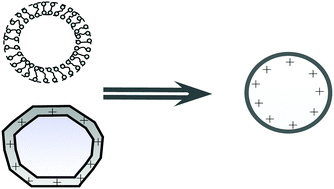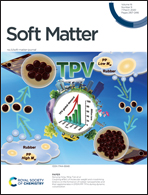Osmotic stress and pore nucleation in charged biological nanoshells and capsids†
Abstract
A model system is proposed to investigate the chemical equilibrium and mechanical stability of biological spherical-like nanoshells in contact with an aqueous solution with added dissociated electrolyte of a given concentration. The ionic chemical equilibrium across the permeable shell is investigated in the framework of an accurate Density Functional Theory (DFT) that incorporates electrostatic and hardcore correlations beyond the traditional mean-field (e.g., Poisson–Boltzmann) limit. The accuracy of the theory is tested by a direct comparison with Monte Carlo (MC) simulations. A simple analytical expression is then deduced which clearly highlights the entropic, electrostatic, and self-energy contributions to the osmotic stress over the shell in terms of the calculated ionic profiles. By invoking a continuum mean-field elastic approach to account for the shell surface stress upon osmotic stretching, the mechanical equilibrium properties of the shell under a wide variety of ionic strengths and surface charges are investigated. The model is further coupled to a continuum mechanical approach similar in structure to a Classical Nucleation Theory (CNT) to address the question of mechanical stability of the shells against a pore nucleation. This allows us to construct a phase diagram which delimits the mechanical stability of capsids for different ionic strengths and shell surface charges.



 Please wait while we load your content...
Please wait while we load your content...
